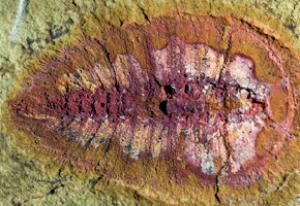
Palaeontologists have extended the range of Burgess Shale type fossils by nearly 20 million years, Ian Randall reports.
Geoscientist Online 8 June 2010
A team of researchers from Yale University have uncovered a rich collection of marine organisms, including those of the iconic types originally found in the Burgess Shale, from around Morocco’s Draa valley. Yet this unbelievably well preserved cache comes with a more fantastic twist: rather than being from the Cambrian, like their Burgess Shale counterparts, the creatures hail from the early Ordovician – 19 million years later.
Over 1500 marine fossils have been recovered since the expedition began studying the region last year. The creatures, many of which are unique, were first noted by a local collector, Mohammed Ou Said Ben Moulla. The animals, which would have lived between 480 million and 472 million years ago, are the earliest known soft-bodied creatures to have been preserved from the Ordovician Period.
A large number of the finds, which are reported in a recent issue of the journal
Nature, are complete specimens. Most have been flattened under the pressure of overlying sedimentation, although some of the worms do show a degree of three-dimensional preservation.
The fossils are mainly of benthic creatures and, while some were more complex animals with hard shells and exoskeletons (such as echinoderms, molluscs, trilobites and even a species that greatly resembles the modern-day horseshoe crab - the first known of its kind), two-thirds of the specimens collected so far are soft-bodied.
“A striking feature is the high number of [these] organisms archetypal of Cambrian Burgess Shale-type faunas, including various demosponges, annelid worms, and other stem arthropods,” said Peter Van Roy, the Yale palaeontologist who led the expedition.
Until now, we had an incomplete understanding of the creatures that populated our oceans in the Ordovician period – a time in which, following the emergence of complex animal life in the Cambrian Explosion, the oceans played host to an exponential increase in the variety of life. This growth in diversity took place over a 25 million year period, grandly named ‘The Great Ordovician Biodiversity Event’.
The rocks here, from the Lower Fezouata Formation, are mainly mudstones and siltstones, implying a deep-water setting at the time of deposition; while the fossilised tissues, which are concentrated in distinct lenses, are coloured in reddish-browns and yellows. The low levels of bioturbation show us that the waters of the time were mostly calm, with occasional bouts of rapid burial, indicated by the occasional layers of coarse sandstone and shell fragments – most likely brought on by heavy storms.
“The early Ordovician was a critical moment when massive diversification takes off, but we were only seeing a small piece of the picture that was based almost exclusively on the shelly fossil record," said Derek Briggs, director of the Yale Peabody Museum of Natural History. “Normal faunas are dominated by the soft-bodied organisms we knew were missing, so these exceptionally well-preserved fossils have filled in much of the missing picture."
Beyond expanding our general understanding of Ordovician life, however, the Moroccan finds have dispelled the long-held notion that the Burgess Shale-type faunas became extinct at the end of the Middle Cambrian, 499 million years ago.
“It shows that their absence from the fossil record is just preservation – it has noting to do with extinction. It’s just a matter of finding the right rocks from the right setting,” Van Roy adds.
This expedition, however, is believed to have merely scratched the surface of what the Lower Fezouata deposits have to teach us about the early evolution of life.
"We are going to continue working on these sites because, at the moment, we have just seen the tip of the iceberg," Van Roy added. "I'm certain there will be more spectacular fossils coming out of this site in the near future."
- Reference: Ordovician faunas of Burgess Shale type. Peter Van Roy, Patrick J. Orr, Joseph P. Botting, Lucy A. Muir, Jakob Vinther, Bertrand Lefebvre, Khadija el Hariri, Derek E. G. Briggs Nature 465, 215-218 (13 May 2010)